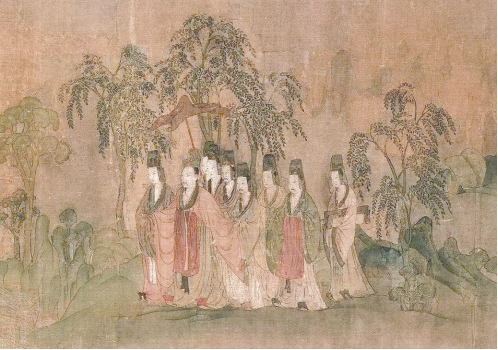Many people are unfamiliar with Hanfu and don’t know the difference between traditional Hanfu and modern Hanfu. Here, I mainly want to talk about some information about them. The earliest records of Hanfu date back more than 5,000 years. The initial form of Hanfu was formed in the Shang Dynasty, which I mentioned in previous articles. In subsequent dynasties, based on this form, many representative Hanfu styles appeared, such as qixiong ruqun (chest-high ruqun) and mianmian skirt. Of course, modern Hanfu evolved from traditional Hanfu, retaining the form, style, and even some craftsmanship of traditional Hanfu designs.

Styles of Traditional Hanfu
Before the Ming Dynasty, Hanfu was mainly elegant and solemn in style. Most of them wrapped around the body in a rotating manner, forming a loose fan-shaped hem that hung to the ground. In the Ming Dynasty, styles like shirts, jackets, skirts, robes, ru (short jackets), and beizi began to feature a simple and grand style, and Ming-style Hanfu is the most popular in the market. During the Qing Dynasty, due to certain reasons, people were required to wear Manchu clothing. Some say Hanfu disappeared in the Qing Dynasty, but in fact, traces of Hanfu can still be seen in the official attire of the Qing Dynasty, though its development was hindered.
Traditional Hanfu has high requirements for wearing methods, making it inconvenient for daily wear. Modern Hanfu has been improved by integrating fashion and daily styles, making it more stylish and in line with modern people’s needs. So, in what aspects has modern Hanfu been improved? This is mainly reflected in the styles. Modern Hanfu has a less complicated structure and decorations, and the colors are more harmonious and natural. Of course, with the progress of science and technology, modern techniques and fabrics have improved the comfort and durability of Hanfu.

Occasions Suitable for Modern Hanfu
I think what everyone cares about most is what occasions modern Hanfu is suitable for. Traditional Hanfu is more suitable for outings and rituals, while modern Hanfu is suitable for a wider range of occasions, such as daily outings, important meetings, and social gatherings.
According to different occasions, modern Hanfu can be roughly divided into three categories: ritual clothing, daily clothing, and casual clothing.

Ritual Clothing
This type of clothing features wide sleeves and long hemlines in appearance, and mostly uses bright colors like red and gold, symbolizing auspiciousness and festivity. It is mainly used for formal occasions such as weddings, sacrifices, and celebrations. In addition, there are specific requirements for hair accessories, earrings, waist ornaments, etc.

Daily Clothing
Daily clothing is designed to be simple, practical, and easy to wear. It is the most common type of modern Hanfu, suitable for various daily occasions. Daily clothing is rich in colors, including red, blue, green, and other choices to meet the needs of different people. Its biggest feature is being relatively loose, making it convenient for the wearer to move.

Casual Clothing
Casual clothing adopts designs such as narrow sleeves and short jackets, suitable for leisure, travel, and other occasions. The colors are relatively elegant, such as white, gray, beige, etc., giving a fresh and natural feeling.
Now, as Hanfu gradually integrates into our daily lives, there is no need to over worry about wearing methods. As long as the matching is harmonious and the wear is comfortable, you can more freely choose suitable styles.







